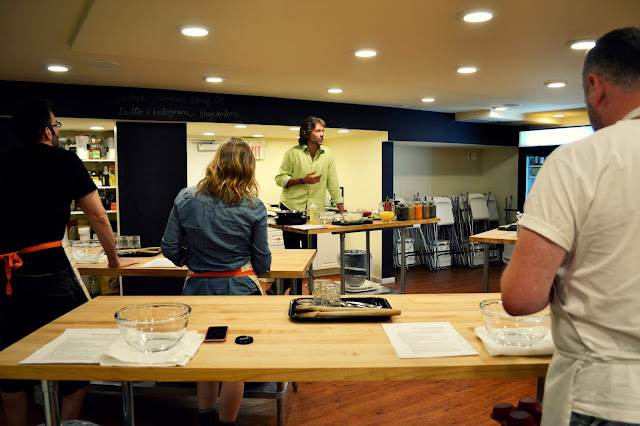Last week I wrote about my lentils experience in Saskatchewan farm country and today I'm back with more about cooking with lentils. One of the highlights of that trip for me was a private lentils cooking class with Chef Michael Smith, where our small group of food writers and bloggers learned the basics of cooking lentils and explored the multitude of flavour ideas for lentils in the kitchen.
If you know me, you know how excited I would have been about meeting Chef Michael Smith. So much of what I do in the kitchen is inspired by his family-focused, just-give-it-a-try attitude. So when we shook hands in a Regina hotel lobby on the first night of the trip, I was grinning up at him, all smiles and few words, with his latest cookbook Family Meals tucked in my tote bag, which he signed for me later at dinner.
The day of the cooking class started with a trip to the warm, wide open fields of a lentil farm and processing plant near Moose Jaw. We saw how lentils are grown and processed to be shipped to markets and dinner tables around the world. Standing around all that food in all those fields inspired the home cook in me, and by the time we were driving back to Regina for our class I was pumped to get into the kitchen with Michael and start creating something delicious.
Our class was held in the beautiful kitchen space at Schoolhaus Culinary Arts in Regina. Each of us took up a work station and tied on an apron to learn from the Lentil Hunter himself.
We started by learning about the most common lentil types found in stores - whole green, split red, whole red, French green, and black beluga - as well as how to cook lentils (it's so easy - see the bottom of this post for simple instructions). Chef Michael told us about how he even cooks lentils ahead of time and freezes them to speed up dinner prep on busy nights. Then we watched his demonstration of lentil tacos, using lentils sautéed with taco spices like chili powder and cumin as the filler, before moving on to the hands-on portion of the class.
The hands-on task was all about salads. Each of us whipped up our own lentil salad using any variety of lentils plus fresh vegetables, herbs, dried fruit, spices, nuts, seeds and more! An incredible array of ingredients were at our disposal, including a vinaigrette station with different oils, vinegars, sweet options and spices.
It was fun to move about the room, grabbing a bit of this and a bit of that and seeing what others were coming up with. For my salad, I decided to go in a distinctly Asian-inspired direction with a vinaigrette made with rice vinegar, sesame oil, vegetable oil, fresh ginger, wasabi, Dijon, soy sauce and a touch of brown sugar. For the salad, I chose black beluga lentils for their dark and dramatic colour, plus grated carrot, chopped cucumber, cilantro, basil and chopped green onion.
When we were finished, we lined up our salad creations on a work surface and marked with chalk on the wall what our dish was called - mine was Ginger Wasabi Beluga Lentil Salad. It was fascinating to see the variety of flavour directions people went in. There was everything from Tex-Mex to Dijon dressing to BLT flavours written on our Lentil Hall of Fame wall.
We ended with a tasting, of course. What a delicious opportunity to try lentils prepared with many different flavours, and they were all so good. It was like a lentil-themed summer potluck!
Back at home now, I'm wanting to cook with lentils even more. In fact, I picked up another bag at the grocery store last night and have plans to recreate a version of my cooking class salad at home.
Cooking lentils is easy! Here's how, with instructions from Canadian Lentils:
The 1-2-3 Lentil Cooking Steps
Step 1: Rinse lentils under running water
Step 2: Boil (5 to 30 minutes, depending on lentil class and recipe - see below)
Step 3: Season (optional)
Rule of thumb for 1 cup of dry lentils:
Whole Lentils Split Lentils
Soak No No
Water needed 2 1/2 to 3 cups 2 cups
Cooking time 20 to 30 minutes 5 to 15 minutes
Final Yield 2 1/2 cups cooked 2 cups cooked
For every cup of whole lentils, add 2 1/2 cups of unsalted water. This will yield 2 1/2 cups of cooked lentils. It's important to use unsalted water, as salt hardens and toughens lentils.
Split lentils generally require less water and take less time to cook. For every cup of split lentils, add 2 cups of unsalted water. This will yield 2 cups of cooked lentils.
What would you put in your lentil salad creation?










